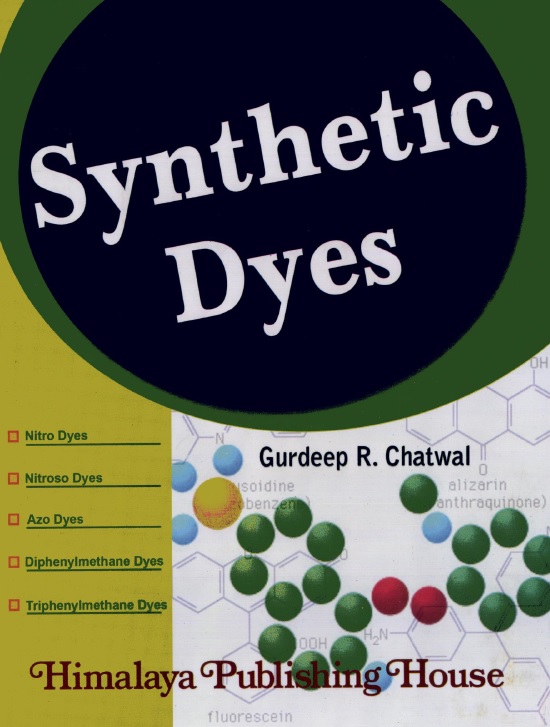by Gurdeep R. Chatwal

CONTENTS
1 Introduction to Dyes …………………………………………………………………………………. 1·1 – 1’9
General InfOl’mation About Fibres and Dyeing Methods ………………………… 2·1 – 2·12
3 Classification of Dyes on the Basis of Mode of Application ……………………… 3·1 – 3’6
4 Chemical Classification of Dyes ………………………………………………………………. 4·1 – 4·10
5 Colour and Chemical Constittition ………•.•………………………………….•…….••…… 5·1 – 5·22
-6 Chemistry of Dyestuff Intermediates …………………………•. ~ ………………………… 6·1 – 6·66
7 Nitro Dyes ……………..•………….•………….•………………….•.•………………………………….. 7·1 – 7’4
8 ,Nitroso Dyes ……………………………………………………………………………………………… 8·1 – 8·3
9 Azo Dyes …………………………………………………………………………………………………. 9·1 – 9·41
10 .Azoic Dyes (I ngrain Azo Dyes) ……………………………•………………………………… 10·1 – 10’3
’11 Diphenylmethane Dyes …………..•…….•….•……………•…………………………….•…•….. 11·1 – 11’3
12 Triphenylmethane Dyes ……………………………………………….. ; ……………………… 12·1 – 12·11
13 Phthaleins ……………………………………………………………………………………………… 13·1 – 13·3
Xanthene Dyes ………………………………………………………………………………………. 14·1 – 14·7
15 Heterocyclic Dyes ………………………………………………………………………………… 15·1 – 15·14
16 Thioindigos and Indigos ………………………………………………………………………… 16’1 – 16·9
17 Anthraquinone Dyes ……………………………………………………………………………… 17·1 – 17·10
18 PhthaJocyanincs …………………………………………………………………………………….. 18’1 – 18·3
19 Sulphur Dyes …………………………………………………………………………………………. 19,) – 19·2
20 Reactive Dyes ………………………………………………………………………………………… 20’1 – 20’5
21 Pigments ………………………………………………………………………………………………. 21·1 – 21’12
Fluorescent Brightening Agents ……………………………………………………………… 22,) – 22’5
23 Non-Textile Uses of Dyestuffs ………………………………………………………………. 23·J – 23·13
24 Acridine Dyes ………………………………………………………………………………………… 24’1 – 24·1
25 Thiazole Dyes ……………………. ………………………………………………………………… 25-1 – 25-2
26 I ngrain Dyes ………………………………………………………………………………………….. 26·1 – 26’1
17 Solubilised Vat Dyes ………………………………………………………………………………. 27·1 – 27’1
28 Sulphurise«J Vat Dyes …………………………………………………………………………….. 28·1 – 28·1
29 Lactone, Amino Ketone and Hydroxy Ketone Dyes ………………………………. 29′) – 29’1
Indamines and Indopbenols …………………………………………………………………… 30·1 – 30·2
Azincs .. ~ …………………………………………………………………………………………………. 31·1 – 31·2
32 Oxazines ………………•……..••..•………………•…………….•………………•……………….•…. 32’1 – 32·1
33 Thiazines ………….•….•………………………•………………………….•……………………….. ,. 33·1 – 33·1
34 Cyanine Dyes …………………………………………………………………………………………. 34·1 – 34’2
35 Dyes for Synthetic Fibres …………………………………………………………………….. 35’1 – 35·12
. 36 Synthesis of Some Specific Dyes ………………………………………………………….. 36·1 – 36·10
37 Important Questions ……………………………………………………………………………. 37·1 – 37’14
INTRODUCTION TO DYES
1.1. Definitions
Dye ‘or Dyestuff: A dye or a dyestuff is usual(v a coloured organic compound or mixture that may be used for imparting colour to a substrate such as cloth, pape/: plastic or lea tIler in a reasonably permallent fashioll. In other words, a dyed substrate should be resistant to a normal laundry or cleansing procedures (washjast) and stable to light (lightfast). All the dyes may not necessarily be coloured substances. Therefore, optical brighteners or whiteners which may be called white dyes may be included in the term dye.
A dye is a coloured substance but all coloured substances are not dyes. Thus a dye should fix itself on the substrate to give it a permanent coloured appearance. Thus, azobenzene is not a dye even though it has red colour, as it cannot be attached to substrate. However, congo red is a dye as it can be applied on cotton and retained by it. Thus, the dyes should have certain groups which help the attachment to the fibre.
@-N=N-<Q)
Azobenzene (Red coloured hut not a dye)
White Dye : Some colourless compounds are used as the optical brighteners. They may also be called as the white dyes. They have the special property of absorbing ultraviolet light and re-emitting the visible light so that the fabric appears bright.
Pigment: The coloured substance which is insoluble in water or other solvents is called a pigment. Thus the application of dye and pigment will he different. A dye is applied in the form of a solution, whereas the pigment is applied in the form of a paste in a drying oil, in which it is insoluble.
Requisites of a True Dye : All coloured substances are not dyes. However, the requisites of a true dye are as follows :
(i) It must have a stable colour.
(if) It must have an attractive c%ur i.e., it should no! undergo struc/ura/changes readiZ)’·
(iii) It must be able to attach itself to material frol1l solution or to be capahle to fixed 01/ it.
For example, azobenzene is coloured but cannot fix itself to a fabric. Therefore. azobenzene is not a dye. Further, a dye may not be able to dye all types of substrates. For example, picric acid is able to dye silk or wool a permanent yellow but not cotton. Thus, a dye either forms a chemical union with the substrate being dyed or it may get associated with it an intimate physical union.
(iv) It must be solu!J.le in water or must form a stable and good di:.persion in watel: Alternatively, it mu;l be soluble in the medium other than water. However, it is to be remembered that the pick lip ~f the dye from the medium should he good.
(v) The substrate to be -(tved must have a natural affini”t y for an appropriate dye and must be able to absorb it from solution or aqueous dispersion. If necessllIJ’, in the presence ~f alcdliary ~’Ubstan(‘es under suitahle conditions of concentratioll. temperatllre and pH.
(vi) When a dye isfixed to a substrate. it must be filst to washing, dry cleaning. perspiration. light, heat and other agencies. It must be resistant to the action of water, acids or alkalis. particularly the latter due to the alkaline nature of washing soda and washing soap. There is probahly no dye which can be guaranteed not to alter shade under all conditions.
(vii) The shade and fastness of a given dye may vary depending on the substrate due to different interactions of the molecular orbitals of the dye with the substrate, and the ease with which the dye may dissipate its absorbed energy to its environment without itself decomposing.
